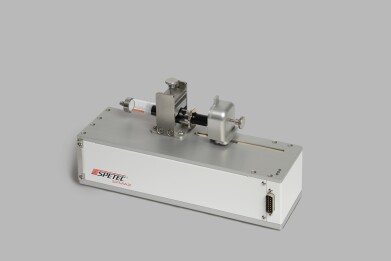Mass spectrometry & spectroscopy
Optimising single-cell analysis through syringe pump technology
Aug 29 2024
Single-particle [sp] mode analysis has become an established method for the analysis of particle suspensions in the ICP-MS field. This type of analysis makes use of a very short mass spectrometer integration time, mostly under 5 milliseconds, and the suspension (of nanoparticles, for example) is diluted in such a way that only a single particle is ever detected in this integration window. This approach has formed the basis for a new trend that is currently being observed and which measures not only biological and medical cells but also particles, but in this case with a diameter > 5 µm. This technique is referred to as single-cell analysis. However, unlike in the case of SP-ICP-MS, it is advisable when adopting this method to use not a conventional peristaltic pump but instead a syringe pump to transport the sample, because cells may become crushed between the walls of peristaltic pump tubing, thereby distorting the results of such ‘single-cell’ analyses. An alternative mode of sample provision by means of a syringe pump is therefore recommended.
Syringe pumps are already in use in many laboratories and in particular whenever it is necessary to meter or continuously transport nanolitre or microlitre volumes. Such applications require a particularly high level of precision, and this is usually reflected in the price paid to acquire the associated technology. Delivery rates of up to 1,000 µL per minute of the type required in ICP-AES or ICP-MS therefore tend to occur only in exceptional cases, which is why Spetec developed a syringe pump to meet the specific requirements of atomic spectroscopy, and that offers excellent value for money. This pump was used in a study conducted by the working group headed by Gunda Köllensperger at Vienna University into the take-up and kinetics of new cytostatic drugs in the treatment of cancer cells. The method makes use of a time-resolution single-cell analysis during which a time-of-flight mass spectrometer (icpTOF 2R; TOFWERK AG, Thun, Switzerland) is used in the place of a conventional quadrupole-based mass spectrometer. ICP-TOF-MS has the advantage of delivering a genuine multi-element analysis of the individual cells given that sequential-measurement quadrupole or sector-field devices assure only the time-resolution analysis of an individual isotope. For this experiment, yeast cells (pichia pastoris) were incubated with cisplatin (5 µM, 37°C, 24h). After this, the cells were washed and filled into the syringe of the syringe pump. The delivery rate of 10 µL per minute was adapted to the employed nebuliser (Parallel Path PFA 260, AHF Analysentechnik, Tübingen). ICP-TOF-MS simultaneously records the data of all isotopes in the mass range m/Z 2 – 257 and, when calibrated appropriately, the measured intensity can be converted directly into femtograms per single cell. This study was able to show that it is possible to determine the presence of metals in the low femtogram range in individual cells. The masses determined for the elements in individual cells correlated closely to the decomposed average values of the results of an ICP-MS analysis conducted on a large number of cells. However, decomposing the results of such multi-cell analyses leads to the loss of one important piece of information, namely the information relating to the heterogeneity of the cell system, because the distribution is not Gaussian, as can be concluded from the fact that individual cells are able to absorb disproportionately large amounts of cisplatin. However, if this cisplatin distribution is compared with that of other essential elements (Fe, Cu, Zn), then it can be seen that this specific distribution is due to the biological variability of the cells. Overall, this study shows that careful sample delivery by means of a syringe pump significantly simplifies single-cell analysis using ICP-MS, permitting detection limits for Cu and Zn in the lower attogram range and for P and Fe in the lower femtogram range. Using the method presented here, it will now be possible to investigate other cell systems with medical relevance in order to examine the way they interact with new, metal-bearing cytostatic drugs. Naturally, this type of investigation can also be performed using conventional ICP-MS equipment. However, in this case, it is necessary to measure the individual isotopes of the metals of interest one after the other, thereby significantly lengthening the duration of the analysis. This method is applicable not only in pharmaceutical research but also in toxicological investigations, potentially explaining the transport of nanoparticles or toxic heavy metals in cells.
More information online
Digital Edition
Lab Asia 32.2 April
April 2025
Chromatography Articles - Effects of small deviations in flow rate on GPC/SEC results Mass Spectrometry & Spectroscopy Articles - Waiting for the present to catch up to the future: A bette...
View all digital editions
Events
Analytica Anacon India & IndiaLabExpo
Apr 23 2025 Mumbai, India
Apr 23 2025 Moscow, Russia
Apr 24 2025 Istanbul, Turkey
Apr 27 2025 Portland, OR, USA
Making Pharmaceuticals Exhibition & Conference
Apr 29 2025 Coventry, UK



















